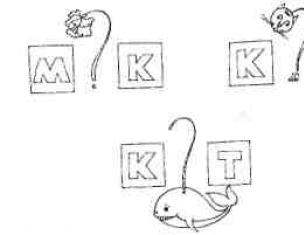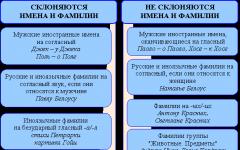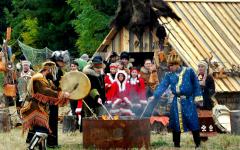The question of the Sumerian language is perhaps the most important secret of this civilization. Archaeologists do not have much, but still have enough objects for excavation - the ruins of Sumerian cities hidden under the ground and sand. Historians study, translate and compare the texts of the cuneiform clay tablets of the Sumerians, which contain information about various fields life of this society, from everyday everyday issues to diplomatic treaties and legendary epics. But linguists still can’t solve the problem: about a century and a half ago they deciphered the Sumerian cuneiform, but the research doesn’t go any further...
Much is known about the Sumerian language...
However, it is not entirely correct to talk about the Sumerian language as completely mysterious. In fact, information about the language of this ancient civilization  scientists have a lot. Thanks to the deciphering of cuneiform tablets, historians were able to find out that the Sumerian language spread to Mesopotamia in the 4th millennium BC and was used as the main spoken language until the beginning of the 2nd millennium BC. After that spoken language These territories became the language of the new conquerors, the Akkadians, but the Sumerian language continued for many centuries to remain the main universal written language of the region, actively used for contacts between different peoples and states. Final consumption Sumerian language stopped around the 2nd century BC, that is, after the conquest of the Persian Empire by Alexander the Great
scientists have a lot. Thanks to the deciphering of cuneiform tablets, historians were able to find out that the Sumerian language spread to Mesopotamia in the 4th millennium BC and was used as the main spoken language until the beginning of the 2nd millennium BC. After that spoken language These territories became the language of the new conquerors, the Akkadians, but the Sumerian language continued for many centuries to remain the main universal written language of the region, actively used for contacts between different peoples and states. Final consumption Sumerian language stopped around the 2nd century BC, that is, after the conquest of the Persian Empire by Alexander the Great  .
.
In addition, based on materials from cuneiform tablets, linguists were even able to identify periods of development of the Sumerian language: archaic (3200 - 2750 BC); Old Sumerian (2750 - 2136 BC); Neo-Sumerian (2136 - 1196 BC); Late Sumerian (1996 - 1736 BC); post-Sumerian, that is, the period when language developed only in written form, without practical use oral speech living native speakers (XVIII - II centuries BC). Moreover: in our time, significant efforts are being made to restore the phonetics, the sound of the Sumerian language, that is, to restore its oral form. True, it's quite difficult task, since Sumerian writing is polyphonic, that is various symbols have different pronunciations.
The main mysteries have not been solved
 However, all these important achievements of scientists for science are still this moment faded into the background. When ancient language has many monuments, when writing has been generally restored, which makes it possible to translate complex texts into the most different topics Even when the phases and features of language development have been established, the main question becomes about its origin. Since it is linguistic data that is fundamental in the study of the question of family ties of various ancient peoples, their relationships, habitats and territorial migrations. In such cases, archaeological data is usually either sorely lacking or completely absent.
However, all these important achievements of scientists for science are still this moment faded into the background. When ancient language has many monuments, when writing has been generally restored, which makes it possible to translate complex texts into the most different topics Even when the phases and features of language development have been established, the main question becomes about its origin. Since it is linguistic data that is fundamental in the study of the question of family ties of various ancient peoples, their relationships, habitats and territorial migrations. In such cases, archaeological data is usually either sorely lacking or completely absent.
But so far, linguists cannot boast: the origins and connections of the Sumerian language have not been established, therefore, there are no answers to the questions of where the Sumerian ethnic group was formed, what route it took to Mesopotamia, and what ethnic groups were formed along with it. At the same time, many hypotheses have been created on this topic and here are a few of them:

Philologist Martin Worthington from the University of London has created a special website aimed at uniting people interested in the language of the ancient inhabitants of Babylon - the Sumerians. On this site you can listen to how Sumerian tales, legends or stories sound.
The language of the ancient Sumerians existed in the 4th-1st millennia BC and to date there is not a single person left on Earth who would be its carrier.

Sumer is a civilization that existed in the southeast of Mesopotamia (the area between the Euphrates and Tigris in the south of modern Iraq) in the 4th-3rd millennia BC. uh... Considered the first civilization on Earth.
In the second half of the 4th millennium BC. e. in southern Mesopotamia, the Sumerians appeared - a people who in later written documents call themselves “black-headed” (Sumerian “sang-ngiga”, Akkadian “tsalmat-kakkadi”). They were a people ethnically, linguistically and culturally alien to the Semitic tribes who settled Northern Mesopotamia at approximately the same time or somewhat later. The Sumerian language, with its bizarre grammar, is not related to any of the surviving languages. They belong to the Mediterranean race. Attempts to find their original homeland have so far ended in failure. Apparently, the country from which the Sumerians came was located somewhere in Asia, rather in a mountainous area, but located in such a way that its inhabitants were able to master the art of navigation. Evidence that the Sumerians came from the mountains is their way of building temples, which were erected on artificial embankments or on terraced hills made of brick or clay blocks.
The Sumerians are credited with the invention of cuneiform writing, possibly the wheel, baked bricks, and irrigation systems. The Sumerians invented the world's first irrigation canals. They learned to drain swamps and bring water to fields several centuries earlier than the Egyptians. There was neither stone nor wood in their country, and they made the stone themselves - they burned clay bricks and built houses and temples from them. They built cities that were the oldest in the world, and the architectural and construction techniques developed by their architects entered into the practice of peoples who did not even suspect the existence of their teachers.
Today it is known for certain that the first Sumerian cities arose at the end of the 4th - beginning of the 3rd millennium BC. Trade flourished in the cities, and artisans made magnificent ceramics and bronze tools. Each of the cities was an independent state, ruled by a king-ensi. Cuneiform tablets tell of wars fought over land, water, and slaves. They describe in detail the methods of farming on the royal lands and in the homes of citizens. The Sumerians practiced boxing, wrestling, hunting, and also participated in horse racing on light two-wheeled carts drawn by donkeys. Their priests watched the sun and stars from the walls of sacred towers. They calculated how many days there are in a year, divided the year into twelve months, a week into seven days, and determined that there are twenty-four hours in a day, and sixty minutes in an hour.
According to Worthington himself, he himself can communicate on some topics in the Sumerian language, the sound of the words in which was, one way or another, reconstructed.
“True, I would still need an interlocutor to understand myself better.”, admitted the researcher. For this purpose, the scientist and a group of like-minded people created a unique website - Babylonian and Assyrian Poetry and Literature Project (Babylonian and Assyrian Poetry and Literary Project), on which recordings are posted literary works Sumerians, as well as other ancient inhabitants of the Tigris and Euphrates rivers (modern Iraq) - Assyrians, Akkadians, Chaldeans and so on. Each person can try his hand at reading the ancient inscriptions of these peoples that have come down to us.
Welcome to the Russian-Sumerian dictionary. Please write the word or phrase you want to check in the text box on the left.
Recent Changes
Glosbe is home to thousands of dictionaries. We offer not only a Russian-Sumerian dictionary, but also dictionaries for all existing pairs of languages - online and free. Visit home page our website to choose from the available languages.
Translation Memory
Glosbe dictionaries are unique. On Glosbe you can see not only translations into Russian or Sumerian: we provide usage examples, showing dozens of examples of translated sentences containing translated phrases. This is called "translation memory" and is very useful for translators. You can see not only the translation of a word, but also how it behaves in a sentence. Our memory of translations comes mainly from parallel corpora that were made by people. This kind of sentence translation is a very useful addition to dictionaries.
Statistics
We currently have 217 translated phrases.
We currently have 5,729,350 sentence translations
Cooperation Help us in creating the largest Russian - Sumerian dictionary online. Just login and add new translation
You should know that Glosbe is not filled with words, but with ideas about what those words mean. Thanks to this, by adding one new translation, dozens of new translations are created! Help us develop Glosbe dictionaries and you will see how your knowledge helps people around the world.
Type: syllabic-ideographic
Language family: not installed
Localization: Northern Mesopotamia
Propagation time:3300 BC e. - 100 AD
e.
The Sumerians called the homeland of all mankind the island of Dilmui, identified with modern Bahrain in the Persian Gulf.
The earliest is represented in texts found in the Sumerian cities of Uruk and Jemdet Nasr, dated 3300 BC. The Sumerian language still continues to remain a mystery to us, since even now it has not been possible to establish its relationship with any of the known language families
. Archaeological materials suggest that the Sumerians created the Ubaid culture in the south of Mesopotamia at the end of the 5th - beginning of the 4th millennium BC. e. Thanks to the emergence of hieroglyphic writing, the Sumerians left many monuments of their culture, imprinting them on clay tablets.
The cuneiform script itself was a syllabic script, consisting of several hundred characters, of which about 300 were the most common; these included more than 50 ideograms, about 100 signs for simple syllables and 130 for complex ones; there were signs for numbers in the hexadecimal and decimal systems. Sumerian writing

developed over 2200 years
Most signs have two or several readings (polyphonism), since often, next to Sumerian, they acquired a Semitic meaning. Sometimes they depicted related concepts (for example, “sun” - bar and “shine” - lah).
The invention of Sumerian writing itself was undoubtedly one of the largest and most significant achievements of the Sumerian civilization. Sumerian writing, which went from hieroglyphic, figurative signs-symbols to the signs that began to write the simplest syllables, turned out to be an extremely progressive system. It was borrowed and used by many peoples who spoke other languages. At the turn of the IV-III millennium BC. e. we have indisputable evidence that the population of Lower Mesopotamia was Sumerian. Wide famous story
Although Sumerian writing was invented exclusively for economic needs, the first written literary monuments appeared among the Sumerians very early: among records dating back to the 26th century. BC e., there are already examples of genres folk wisdom, cult texts and hymns.

Due to this circumstance, the cultural influence of the Sumerians in the Ancient Near East was enormous and outlived their own civilization for many centuries.
Subsequently, writing loses its pictorial character and transforms into cuneiform.
Cuneiform writing was used in Mesopotamia for almost three thousand years. However, later it was forgotten. For tens of centuries, cuneiform kept its secret, until in 1835 the unusually energetic Englishman Henry Rawlinson, an English officer and lover of antiquities, deciphered it. One day he was informed that an inscription had been preserved on a steep cliff in Behistun (near the city of Hamadan in Iran). It turned out to be the same inscription, written in three ancient languages, including ancient Persian. Rawlinson first read the inscription in this language known to him, and then managed to understand the other inscription, identifying and deciphering more than 200 cuneiform characters.
In mathematics, the Sumerians knew how to count in tens. But the numbers 12 (a dozen) and 60 (five dozen) were especially revered. We still use the Sumerian heritage when we divide an hour into 60 minutes, a minute into 60 seconds, a year into 12 months, and a circle into 360 degrees.
In the figure you see how over 500 years hieroglyphic images of numerals turned into cuneiform ones.
Modification of the numerals of the Sumerian language from hieroglyphs to cuneiform
Sumerian cuneiform
Sumerian writing, which is known to scientists from surviving cuneiform texts of the 29th–1st centuries BC. e., despite active study, still largely remains a mystery. The fact is that the Sumerian language is not similar to any of the known languages, so it was not possible to establish its relationship with any language group.
Initially, the Sumerians kept records using hieroglyphs - drawings that denoted specific phenomena and concepts. Subsequently, there was improvement sign system Sumerian alphabet, which led to the formation of cuneiform in the 3rd millennium BC. e. This is due to the fact that records were kept on clay tablets: for ease of writing, hieroglyphic symbols were gradually transformed into a system of wedge-shaped strokes applied in different directions and in various combinations. One cuneiform symbol represented a word or syllable. The writing system developed by the Sumerians was adopted by the Akkadians, Elamites, Hittites and some other peoples. That is why Sumerian writing survived much longer than the Sumerian civilization itself existed.
According to research, a unified writing system in the states of Lower Mesopotamia was used already in the 4th–3rd millennia BC. e. Archaeologists have managed to find many cuneiform texts. These are myths, legends, ritual songs and hymns of praise, fables, sayings, debates, dialogues and edifications. Initially, the Sumerians created writing for economic needs, but soon it began to appear fiction. The earliest cult and artistic texts date back to the 26th century BC. e. Thanks to the works of Sumerian authors, the genre of tale-argument developed and spread, which became popular in the literature of many peoples of the Ancient East.
It is believed that Sumerian writing spread from one place, which at that time was an authoritative cultural center. Much of the data obtained during scientific work, suggest that this center could be the city of Nippur, in which there was a school for scribes.
Archaeological excavations of the ruins of Nippur first began in 1889. Many valuable finds were made during excavations that took place shortly after the Second World War. As a result, the ruins of three temples and a large cuneiform library with texts on a variety of issues were discovered. Among them was the so-called “school canon of Nippur” - a work intended for study by scribes. It included tales about the exploits of the great heroes-demigods Enmesharra, Lugalbanda and Gilgamesh, as well as other literary works.

Sumerian cuneiform: above - stone tablet from the library of the Assyrian king Ashurbanipal; at the bottom - fragment of a diorite stela on which the code of laws of the Babylonian king Hammurabi is written
Extensive cuneiform libraries were found by archaeologists in the ruins of many other cities of Mesopotamia - Akkad, Lagash, Nineveh, etc.
One of the important monuments of Sumerian writing is the “Royal List”, found during the excavations of Nippur. Thanks to this document, the names of the Sumerian rulers have reached us, the first of whom were the heroic demigods Enmesharr, Lugalbanda and Gilgamesh, and legends about their deeds.
Legends tell of a dispute between Enmesharr and the ruler of the city of Aratta, located far in the East. Legend connects the invention of writing with this dispute. The fact is that the kings took turns asking each other riddles. No one was able to remember one of Enmesharr's ingenious riddles, which is why the need arose for a method of transmitting information other than oral speech.
The key to deciphering cuneiform texts was found completely independently of each other by two amateur researchers G. Grotenfend and D. Smith. In 1802, Grotenfend, analyzing copies of cuneiform texts found in the ruins of Persepolis, noticed that all cuneiform signs have two main directions: from top to bottom and from left to right. He came to the conclusion that texts should not be read vertically, but horizontally, from left to right.
Since the texts he studied were funerary inscriptions, the researcher suggested that they might begin in much the same way as later inscriptions in Persian: “So-and-so, great king, king of kings, king of such and such places, son of the great king...” As a result of analyzing the available texts, the scientist came to the conclusion that the inscriptions distinguish those groups of signs that should, according to his theory, convey the names of the kings.
In addition, there were only two options for the first two groups of symbols that could mean names, and in some texts Grotenfend found both options.
Further, the researcher noticed that in some places the initial formula of the text does not fit into its hypothetical scheme, namely, in one place there is no word denoting the concept of “king”. The study of the arrangement of signs in the texts made it possible to make the assumption that the inscriptions belong to two kings, father and son, and the grandfather was not a king. Since Grotenfend knew that the inscriptions referred to Persian kings (according to the archaeological research during which these texts were discovered), he concluded that they were most likely talking about Darius and Xerxes. By correlating the Persian spelling of names with the cuneiform, Grotenfend was able to decipher the inscriptions.
No less interesting is the history of the study of the Epic of Gilgamesh. In 1872, an employee of the British Museum, D. Smith, was deciphering cuneiform tablets found during the excavations of Nineveh. Among the tales about the exploits of the hero Gilgamesh, who was two-thirds a deity and only one-third a mortal man, the scientist was especially interested in a fragment of the legend of the Great Flood:
This is what Utnapishtim says to the hero, who survived the flood and received immortality from the gods. However, later in the story there began to be gaps, a piece of text was clearly missing.
In 1873, D. Smith went to Kuyundzhik, where the ruins of Nineveh had previously been discovered. There he was lucky enough to find the missing cuneiform tablets.
After studying them, the researcher came to the conclusion that Utnapishtim is none other than the biblical Noah.
The story of the ark, or ship, which Utnapishtim ordered on the advice of the god Ea, the description of a terrible natural disaster that struck the earth and destroyed all life except those who boarded the ship, surprisingly coincides with the biblical story of the Great Flood. Even the dove and raven, which Utnapishtim releases after the end of the rain to find out whether the waters have subsided or not, are also in the biblical legend. According to the Epic of Gilgamesh, the god Enlil made Utnapishtim and his wife like gods, that is, immortal. They live across the river that separates the human world from the other world:
Hitherto Utnapishtim was a man,
From now on, Utnapishtim and his wife are like us, gods;
Let Utnapishtim live at the mouths of rivers, in the distance!
Gilgamesh, or Bilga-mes, whose name is often translated as “ancestor-hero,” the hero of the Sumerian epic, was considered the son of the hero Lugalbanda, the high priest of Kulaba, ruler of the city of Uruk, and the goddess Ninsun.
According to the “Royal List” from Nippur, Gilgamesh ruled Uruk for 126 years in the 27th–26th centuries BC. e.

Gilgamesh with a lion. VIII century BC e.
Gilgamesh was the fifth king of the first dynasty, to which his father Lugalbanda and Dumuzi, the husband of the goddess of love and war Inanna, belonged. For the Sumerians, Gilgamesh is not just a king, but a demigod possessing superhuman qualities, therefore his deeds and the duration of his life significantly exceed the corresponding characteristics of the subsequent rulers of Uruk.
The name of Gilgamesh and the name of his son Ur-Nungal were found in the list of rulers who took part in the construction of the general Sumerian temple of Tummal in Nippur. The construction of a fortress wall around Uruk is also associated with the activities of this legendary ruler.
There are several ancient tales about the exploits of Gilgamesh. The story "Gilgamesh and Agga" tells of real events end of the 27th century BC e., when the warriors of Uruk defeated the troops of the city of Kish.
The tale “Gilgamesh and the Mountain of the Immortal” tells of a trip to the mountains where warriors led by Gilgamesh defeat the monster Humbaba. The texts of two tales – “Gilgamesh and the Bull of Heaven” and “The Death of Gilgamesh” – are poorly preserved.
Also, the legend “Gilgamesh, Enkidu and the Underworld” has reached us, which reflects the ideas of the ancient Sumerians about the structure of the world.
According to this legend, in the garden of the goddess Inanna there grew a magical tree, from the wood of which the goddess intended to make herself a throne. But the Anzud bird, a monster that caused thunderstorms, and the demon Lilith settled on the tree, and a snake settled under the roots. At the request of the goddess Inanna, Gilgamesh defeated them, and from wood he made for the goddess a throne, a bed and magical musical instruments, to the sounds of which the young men of Uruk danced. But the women of Uruk became indignant at the noise, and the musical instruments fell into the realm of the dead. The servant of the ruler of Uruk, Enkidu, went to get musical instruments, but failed to return back. However, at the request of Gilgamesh, the gods allowed the king to talk with Enkidu, who told him about the laws of the kingdom of the dead.
Tales of the deeds of Gilgamesh became the basis of the Akkadian epic, cuneiform records of which were discovered during excavations of Nineveh in the library of the Assyrian king Ashurbanipal, dated to the second half of the 2nd millennium BC. e. There are also several different versions, records of which were found during excavations in Babylon and in the ruins of the Hittite kingdom.
The text that was discovered in Nineveh, according to legend, was written down from the words of the Uruk spellcaster Sinlique-uninni. The legend is recorded on 12 clay tablets. Separate fragments of this epic were found in Ashur, Uruk and Sultan Tepe.
The audacity and strength of the king of Uruk forced the inhabitants of the city to turn to the gods for protection from his tyranny. Then the gods created the strongman Enkidu from clay, who entered into single combat with Gilgamesh. However, the heroes became not enemies, but friends. They decided to take a hike into the mountains for cedars. The monster Humbaba lived in the mountains, whom they defeated.
The story goes on to tell how the goddess Inanna offered her love to Gilgamesh, but he rejected her, reproaching her for being unfaithful to her former lovers. Then, at the request of the goddess, the gods send a gigantic bull that seeks to destroy Uruk. Gilgamesh and Enkidu defeat this monster, but Inanna's anger causes the death of Enkidu, who suddenly loses his strength and dies.
Gilgamesh grieves for his dead friend. He cannot come to terms with the fact that death awaits him, so he goes in search of a herb that gives immortality. Gilgamesh's journeys are like those of many others. legendary heroes to another world. Gilgamesh passes the desert, crosses the “waters of death” and meets the wise Utnapishtim, who survived the flood. He tells the hero where you can find the herb of immortality - it grows at the bottom of the sea. The hero manages to get it, but on the way home he stops at a spring and falls asleep, and at this time a snake swallows the grass - so the snakes change their skin, thereby renewing their lives. Gilgamesh has to give up his dream of physical immortality, but he believes that the glory of his deeds will live in the memory of people.
It is interesting to note that the ancient Sumerian storytellers were able to show how the character of the hero and his worldview were changing. If at first Gilgamesh demonstrates his strength, believing that no one can resist him, then as the plot develops, the hero realizes that human life is short and fleeting. He thinks about life and death, experiences grief and despair. Gilgamesh is not used to submitting even to the will of the gods, so the thought of the inevitability of his own end causes him to protest.
The hero does everything possible and impossible to break out of the tight confines of what fate has destined for him. The tests he has passed make him understand that this is possible for a person only thanks to his deeds, the glory of which lives in legends and traditions.
Another written monument made in cuneiform is the code of laws of the Babylonian king Hammurabi, dated approximately 1760 BC. e. A stone slab with the text of laws carved on it was found by archaeologists at the beginning of the 20th century during excavations in the city of Susa. Many copies of the Code of Hammurabi were also found during excavations of other Mesopotamian cities, such as Nineveh. The Code of Hammurabi is different high degree legal elaboration of concepts and the severity of punishments for various crimes. The laws of Hammurabi had a huge impact on the development of law in general and on legal codes different nations in later eras.
However, the Code of Hammurabi was not the first collection of Sumerian laws. In 1947, archaeologist F. Style, during excavations of Nippur, discovered fragments of the legislative code of King Lipit-Ishtar, dated to the 20th century BC. e. Law codes existed at Ur, Isin and Eshnunna: they were probably taken as a basis by the developers of the Code of Hammurabi.
This text is an introductory fragment. From the book When Cuneiform Spoke author Matveev Konstantin PetrovichChapter III When cuneiform began to speak Created several millennia BC, cuneiform was an outstanding phenomenon in the cultural life of mankind, in the history of human civilization. Thanks to cuneiform writing, people were able to record their achievements in various
authorPart 1. Sumerian civilization
From the book Ancient Sumer. Essays on culture author Emelyanov Vladimir VladimirovichPart 2. Sumerian culture
From the book History Ancient world. Volume 1. Early antiquity [various. auto. edited by THEM. Dyakonova] author Sventsitskaya Irina SergeevnaLecture 5: Sumerian and Akkadian culture. Religious worldview and art of the population of lower Mesopotamia of the 3rd millennium BC. Emotionally colored comparison of phenomena according to the principle of metaphor, i.e. by combining and conditionally identifying two or more
From the book Sumerians. The Forgotten World [edited] author Belitsky MarianThe Sumerian parable about “Job” The story of how severe suffering befell a certain man - his name is not given - who was distinguished by his health and was rich, begins with a call to praise God and offer prayer to him. After this prologue, a nameless man appears
From the book History of the Ancient East author Lyapustin Boris Sergeevich“The Sumerian mystery” and the Nippurian union With the settlement at the beginning of the 4th millennium BC. e. On the territory of Lower Mesopotamia, the Sumerian aliens, the archaeological culture of Ubaid was replaced here by the Uruk culture. Judging by the later memories of the Sumerians, the original center of their settlement
From the book History of World Civilizations author Fortunatov Vladimir Valentinovich§ 3. Sumerian civilization One of ancient civilizations, along with the ancient Egyptian, is the Sumerian civilization. It originated in Western Asia, in the valley of the Tigris and Euphrates rivers. This area was called Mesopotamia in Greek (which in Russian sounds like “interfluve”). IN
From the book Sumerians. Forgotten World author Belitsky Marian From the book The History of Weddings author Ivik OlegMarriage cuneiform For some, marriages take place in heaven, for others - on sinful earth. For residents ancient Mesopotamia marriages took place mainly in the bowels of the bureaucratic machine. On the banks of the Tigris and Euphrates, they generally loved accounting and control. All events: and past,
From book The Ancient East author Nemirovsky Alexander ArkadevichThe Sumerian riddle One of the traditional riddles of oriental studies is the question of the ancestral homeland of the Sumerians. It remains unresolved to this day, since the Sumerian language has not yet been reliably associated with any of the currently known language groups, although candidates for such a relationship
From the book Curses of Ancient Civilizations. What's coming true, what's about to happen author Bardina Elena From the book 50 Great Dates in World History author Schuler JulesCuneiform Unlike Egypt, where nearby mountains allow stone to be mined in abundance, stone was used little in Mesopotamia (only a few statues and steles survive). Royal palaces and ziggurat temples in the form of multi-story towers were built from dried clay,








